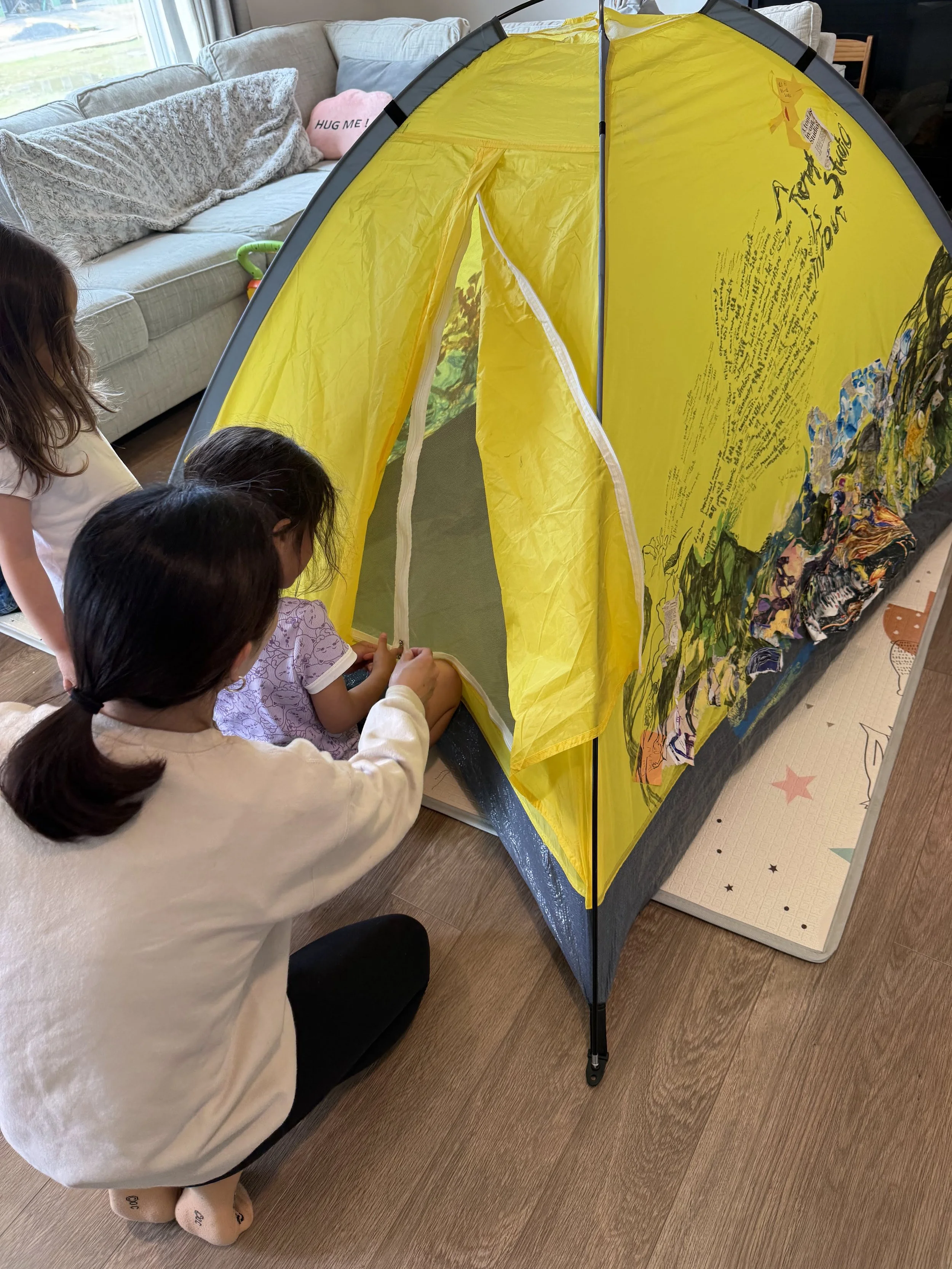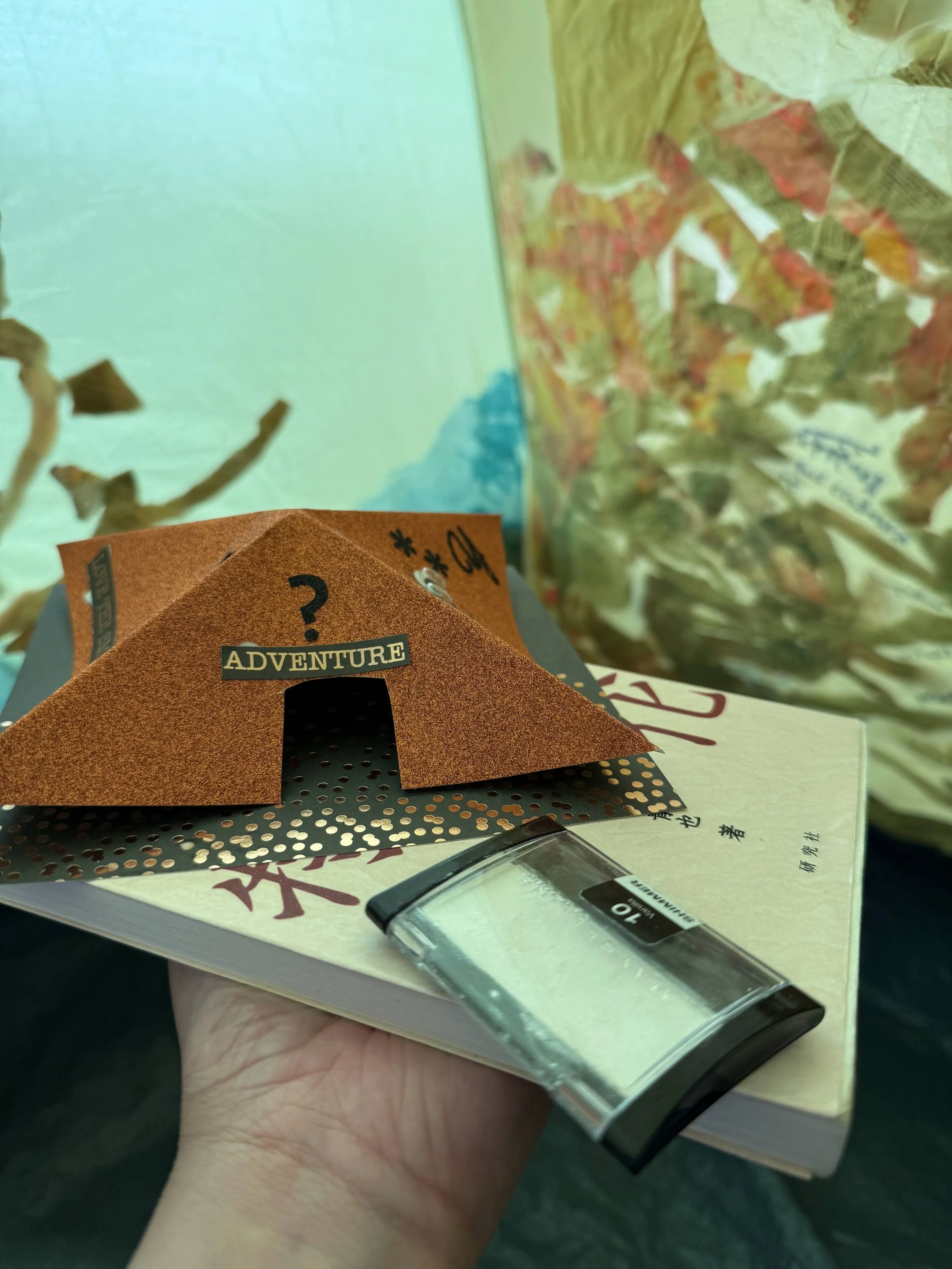
Making space: Cosmetic Foundation Tent
As a Japanese immigrant mother in the United States, Miwa balances the relentless demands of early motherhood with a quiet yearning for reflection and self-expression. Between caregiving interruptions and moments of focus, Miwa transformed her living room into an intergenerational tent studio. Her cosmetic foundation tent embodied transnational memory, from adolescent struggles with beauty norms to her daughter’s playful reinterpretation of cosmetic foundation.
Her first step was an interview, for which she proposed a local café as the site. She explained that she wanted to step briefly outside the domestic sphere and immerse herself in an hour devoted to self-exploration. I arrived early, laying out Taiwanese dried plums and pineapple slices alongside images of my yellow tent. As I waited, I felt the café’s atmosphere as a convergence of many lives—students bent over laptops, parents guiding children, workers pausing for coffee. Soon, I noticed a slightly built Asian woman enter. I stood to greet her.
She picked up a dried plum and smiled, the taste instantly returning her to her childhood in Japan. This tangy flavor stirred a reflection on her teenage years, when her father’s temporary assignment brought her to the United States. That period was her first encounter with the country: a disorienting, vivid exposure to new streets, languages, and cultural norms. Though temporary, the experience planted a seed of curiosity that later shaped her decision to build a life abroad.
After finishing high school and university in Japan, Miwa entered the workforce and eventually met her future spouse, a White American studying Japanese. Their relationship blossomed into marriage and relocation to the United States. Yet her early years in America as a wife and soon-to-be mother were marked by profound isolation. “He has co-workers,” she recalled, “but for me, I had no friends. I didn’t know where to go. So, the first few years were pretty tough.”
Her words revealed not just loneliness but structural exclusion. Visa restrictions prevented her from working, stripping her of professional identity and financial contribution. Life felt monotonous, even stifling. Family-in-law conflicts around parenting norms and holiday practices compounded her struggles. In these early years, she often felt invisible, trapped between domestic obligations and cultural dislocation.
Her solace came through digital communication with friends in Japan. She showed me the Line app on her phone, scrolling through messages exchanged with a close friend. These conversations sustained her, bridging borders and reaffirming belonging. Gradually, through parenting, observation, and later her decision to join the yellow tent project, she began cultivating resilience and agency.
When it came time for tent-artmaking, Miwa chose her home. She also asked to invite a close Japanese friend, explaining that their small community of Japanese mothers supported one another. “It feels like community here,” she said. On a sunny day, I arrived with my yellow carry-on holding the tent. The neighborhood was a new development, half-built houses rising from unsettled ground. Inside, her four-year-old daughter opened the door with a bright smile, while the baby crawled across the floor, patting the surface in playful rhythm.
The living room brimmed with motion—Miwa moving quickly to offer snacks, pick up toys, and calm fussing children. Soon, her friend arrived with two more children. The atmosphere thickened with laughter, multilingual chatter, and playful chaos. As art materials spread across the floor, we communicated through English, Japanese, and gestures. Miwa translated my words about the tent project, her warmth bridging linguistic divides. The living room became a temporary art studio shaped by caregiving, creativity, and community.
Setting up the tent mirrored Miwa’s life rhythm: start, pause, start again. Soothe the baby, intervene in a children’s dispute, offer food, then return to artmaking. I, childless myself, felt the fragmented tempo of her days. Making art was not a straightforward task but an act of carving time and space against competing demands. The process revealed how much privilege lies in having uninterrupted space for reflection. For many immigrant women like Miwa, art and storytelling are constrained by structural pressures and the scarcity of time.
When the yellow tent finally rose, her children rushed inside, transforming it into an ice cream shop, a campsite, and a girls’ room. Their imaginative play infused the tent with joy. Meanwhile, Miwa worked on her smaller tent structure, her daughter drifting in and out of the activity. When Miwa began to share her transnational objects, her daughter interrupted with curiosity, turning ordinary fabric scraps into treasures. Miwa smiled softly, saying, “My daughter first.”'
This intergenerational rhythm was not a disruption but an enrichment. Her daughter’s presence layered the project with continuity, demonstrating how identity construction unfolds relationally, never in isolation.
Miwa entered the yellow tent project carrying the weight of immigrant motherhood. As a Japanese woman raising two young daughters in the United States, she continuously negotiated the unrelenting cycle of feeding, soothing, cleaning, and the unseen labor of emotional caregiving. These tasks defined her daily rhythm, often leaving little room for self-reflection. When I first introduced the idea of participating in the tent-based art project, she hesitated. She was uncertain whether she could carve out the time and presence necessary for meaningful engagement, especially since artistic practices felt unfamiliar. Yet, guided by her friend’s encouragement and a shared recognition of the value of storytelling, Miwa decided to participate.
Miwa presented two objects. The first was a book on Japanese culture from her college years, inspired by a professor who had studied in the United States. The book embodied her view of migration as an adventurous journey. The second object was more intimate: a compact of cosmetic foundation she had purchased in middle school during her U.S. stay. At that time, she had felt inferior to White peers—taller, bigger-eyed, seemingly more beautiful. She had wanted to conceal her Asian features beneath the foundation.
Recently, she almost discarded the compact. Yet her daughter found it, using it in playful role-play. Watching her daughter apply the powder to her own face transformed Miwa’s memory of shame into something lighter, even hopeful. She chose to include the compact in the yellow tent project.
The compact became more than makeup—it became a bridge across decades, a symbol of transnational movement. Purchased in her youth, carried back to Japan, then brought again to the United States, and now held by her daughter, it embodied layered journeys of identity. Her daughter’s playful gestures redefined it, reframing what once symbolized concealment into a narrative of resilience and continuity.
In her artist statement, Miwa reflected that her tent captured both the adventurous spirit of her transnational life and the emotional complexity of parenting. She described how each tent panel resonated with a different layer of experience—migration, motherhood, and memory. Inside the yellow tent, the cosmetic foundation became both literal and metaphorical foundation, holding together fragments of her past and present.
The tent was not about producing a polished art object. It was about creating temporary space for self-reflection, storytelling, and embodied memory. In witnessing Miwa’s process, I recognized how immigrant mothers build identity in porous, fragmented, and relational ways. Her tent revealed how artmaking can exist amid interruptions, caregiving, and translation.
Through the yellow tent, Miwa’s life unfolded as both ordinary and extraordinary. Ordinary in the daily repetitions of caregiving, extraordinary in how she transformed those repetitions into art, meaning, and transnational resilience. The tent became a feminist, participatory space, affirming that immigrant women’s stories matter—not as isolated monologues but as living, relational narratives carried across generations.




